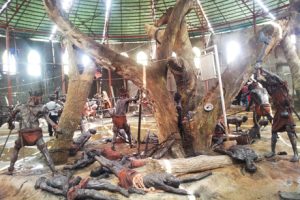
The Ugandan Martyrs are a source of pride for the African continent and the Catholic Church in general.
They are the source of religion and the expansion of Christianity in Uganda. When the first party of Christian missionaries, Shergold-Smith and the Rev. C.T. Wilson, arrived at King Mutesa’s court in Rubaga on June 30, 1877, the work of evangelization in Uganda officially got underway. That was 137 years ago. They belonged to the Church Missionary Society (CMS) and were Anglicans. The Missionaries of Africa’s Brother Amans and Father Simeon Lourdel led the Catholic group that arrived on February 17, 1879. (White Fathers).
People claim that Ugandans immediately adopted Christianity. It is accurate and neither surprising nor false. When the Europeans first came to Uganda, they discovered that Ugandans were distinct from other Africans. Uganda has been called the ” white pearl of Africa” by Winston Churchill. Churchill had been through many African nations before arriving in Uganda. He was moved and astonished by the country’s natural beauty, but most of all, he was struck by how warm and friendly the locals were. These individuals were eager to accept the good news because they were prepared to do so.
All travelers to Uganda were required to present themselves to the King (Kabaka) of the Buganda Kingdom, who would then grant them permission to complete their mission. The Uganda Martyrs worked as royal page boys. After learning more about Christianity and how to read the Bible, these people realized that several of their customs went against what the Bible taught, leading them to reject such customs. The new Kabaka Mwanga, who had succeeded his father, Kabaka Mutesa, viewed their rejection of the new faith as a rebellion and commanded them to renounce it or face death.
Between 1885 and 1887, Kabaka Mwanga had forty-five young men killed as Uganda Martyrs in Kampala: twenty-two Roman Catholics and twenty-three Anglicans. Two more can be added to this total: the two young catechists who perished on October 18, 1918, at Paimol, near Kalongo, Northern Uganda. They had also resisted giving up the new faith they had helped to catechize. The Comboni Missionaries brought the good news of Christ to northern Uganda after arriving from Italy in 1911.
These young Christians received a particular grace from God that allowed them to accept death rather than reject the gift of faith they had just been given. On October 18, 1964, Pope Paul VI recognized and canonized them as holy martyrs because they shed their blood for the Lord Jesus Christ.
We should all conduct a self-evaluation by considering our level of familiarity with the Uganda Martyrs. How has this information affected the choices I’ve made in my life? Together, let’s pray for these martyrs, who are also our brothers, parents, and martyrs for the faith, to intercede on our behalf so that we can live a life of Christian witness and become saints.
Our own brothers and spiritual forebears are the Martyrs of Uganda, who were martyred in the heart of Africa. However, they apply to the entire world as well as the entire international Church of Jesus Christ, the King of Martyrs, not only to Uganda or Africa. Pope Paul VI had a close relationship with the Uganda Martyrs. “The African Martyrs contributes to the martyrology, a page worthy in every way to be added to the annals of that earlier Africa of times that we, living in the era and being men of small faith, never expected to be repeated,” he said in his homily at their canonization on October 18, 1964, in Rome, during the Second Vatican Council. In order to honor and pray with these courageous men of faith, Pope Paul VI traveled to Uganda for the first time in 1969. He also entered the land that had been washed in and hallowed by the blood of martyrs.
These young men’s narrative is one of faith, bravery, tenacity, resilience, and endurance in faithfully following Jesus, the teachings that liberates mankind.
This story has the potential to become our own—the tale of our spiritual journey. I won’t recount this intriguing tale in this brief book; instead, I’ll use it to create a prayer that draws inspiration from it.
Father Simon Lourdel and Brother Amans, the first missionaries (Fathers or Missionaries of Africa) to arrive in Uganda on February 17, 1879, marked the beginning of this narrative and spiritual journey.
It culminated on June 3, 1886, when the majority of these brave young men chose the highest form of witness to Christ: martyrdom, after only ten years of discipleship.
King Kabaka Mwanga misled himself by murdering these young men of faith. He believed he could eradicate the practice of Christianity throughout the nation. Instead, he planted the seeds that would blossom and send forth branches throughout the entire planet.
Another African predecessor, Tertullian, said, “The blood of martyrs is the seed of faith.” When the Kabaka came to the conclusion that killing these fervent and enthusiastic young men of faith was the only way to silence them, it was obvious that he was under a horrible delusion.
The task they have left for us is to live out the call of our Christian life wholeheartedly and in accordance with Christian virtues. There is no other way to honor these great heroes than to carry on proclaiming our faith as they did: firmly, bravely, resolutely, and with a laser-like concentration on heaven, the ultimate destination of our journey.